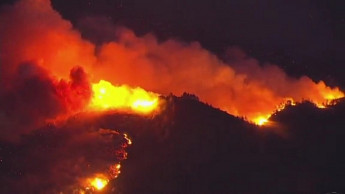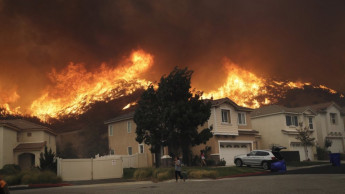California fires
Lake Tahoe residents relieved homes spared from wildfire
Connor Jones sunbathed with his dog on the otherwise empty beach at Ski Run Marina on Monday, as residents trickling back into town filled up their cars at a gas station behind him and employees of a water sports rental company docked jet skis and boats they had anchored away from the shores of Lake Tahoe to prevent them from igniting from wildfire.
He and others living in the resort city of South Lake Tahoe breathed a collective sigh of relief on Sunday when officials downgraded a mandatory evacuation order put in place a week ago to a warning.
“I figure they wouldn’t take repopulation lightly and, if they made the decision to allow people to come back, then they were probably confident that they’re not going to have any issues,” he said.
When the Caldor Fire gobbled up pine trees and crossed the Sierra Nevada last week, South Lake Tahoe, a scenic community of 22,000 people on the California-Nevada state line, transformed into a smoke-choked ghost town.
Read: Lake Tahoe evacuees hope to return home as wildfire slows
After worrying throughout all of last week about the fire approaching their homes and landmarks they hold dear, residents who returned on Monday said they were thankful firefighters had stopped the blazes on the town’s doorstep. But it appeared most residents remained away and most shops remained closed in usually thriving Labor Day destination town.
While many large wildfires have ripped through large swaths of Northern California in recent years, it’s the first time in more than a decade that South Lake Tahoe residents saw a blaze get this close. As of Monday evening, 5,072 firefighting personnel were battling the Caldor Fire, which had scorched roughly 338 square miles (876 square kilometers).
The threat to the region hasn’t entirely vanished, with mandatory evacuation orders remaining for parts of unincorporated El Dorado County south of South Lake Tahoe, including Meyers and Christmas Valley. And questions remain about the smoke blanketing the region and how long it may take for the clean air and crystalline waters that draw millions of tourists to the area annually to return.
Authorities warned residents, that in the absence of humans, bears had gone to town, spreading trash. “The delicate balance between humans and bears has been upset,” and anyone who thinks a bear may have entered their home should call law enforcement, El Dorado County Sheriff’s Sgt. Simon Brown said.
Chirawat Mekrakseree said he had seen signs. of bears sifting through the trash at his restaurant on Lake Tahoe Boulevard, My Thai Cuisine.
Mekrakseree plans to reopen and start serving curries and noodle dishes on Wednesday but worries the tourists he depends on may not come back while the smoke lingers. And he doesn’t know what to tell his staff about when business will return to normal after an already uncertain year with the pandemic, he said.
“Everybody has expenses, rent, car payments,” he said as he power-washed ash off outdoor picnic tables. “They’re asking me how long (until they return to work) and I can’t tell them how long.”
Read:High winds threaten to whip up flames approaching Lake Tahoe
California and much of the U.S. West have experienced dozens of wildfires in the past two months as the drought-stricken region swelters under hot, dry weather and winds drives flames through bone-dry vegetation. More than 14,500 firefighters were battling 14 active fires in the state on Monday, and since the year began more than 7,000 wildfires have devoured 3,000 square miles (8,000 square kilometers).
The lifting of mandatory evacuation orders for the Tahoe area marked a milestone in the fight against the Caldor Fire, which erupted Aug. 14 and spread across nearly 338 square miles (876 square kilometers) of dense national parks and forests, tree-dotted granite cliffs and scattered cabins and hamlets in the northern Sierra Nevada. At its peak, the fire was burning as many as 1,000 acres an hour and virtually razed the small community of Grizzly Flats.
In recent days, winds eased and firefighters took advantage of the better weather to hack, burn and bulldoze fire lines, managing to contain 44% of the perimeter by Monday. Authorities said containment lines were holding up but they were concerned about extremely low humidity and a slight increase in wind, which could spur spot fires up to half a mile (0.8 kilometers) away.
“We are drier than I have seen on my 20 days on this fire,” Jim Dudley, incident meteorologist, said Monday. “There’s a lot of potential weather-wise for little things to become maybe not so little.”
In South Lake Tahoe, gas stations and grocery stores quickly reopened but eateries and a ski gear shops remained closed.
Dakota Jones returned Monday to his apartment with his roommates, who were in the process of moving when the fire approached, and a U-Haul full of their belongings. The Lake Tahoe Community College student said he worried he’d find buildings damaged and ashen, and was pleasantly surprised to see the town largely untouched.
“I was honestly convinced this place was gonna go down,” said Jones, who is not related to Connor. “It was nice to see that I was wrong.”
Read: Wildfire evacuees flood Lake Tahoe roads in rush to flee
California has experienced increasingly larger and deadlier wildfires in recent years as climate change has made the West much warmer and drier over the past 30 years. Scientists have said weather will continue to be more extreme and wildfires more frequent, destructive and unpredictable.
No deaths have been reported specifically from the fires, which have shut down all national forests in the state.
In Northern California, the weather is expected to cool slightly and the humidity to rise starting on Tuesday.
Further south, the National Weather Service in Oxnard, California said hot dry weather was expected for interior valleys and deserts with elevated fire conditions through Friday.
4 years ago
Lake Tahoe evacuees hope to return home as wildfire slows
Firefighters are making progress on a California wildfire threatening South Lake Tahoe, officials said Saturday, lifting hopes for tens of thousands of residents who are waiting this weekend to return to the resort town.
Lighter winds and higher humidity continue to reduce the spread of flames, and fire crews were quick to take advantage by doubling down on burning and cutting fire lines around the Caldor Fire.
Bulldozers with giant blades, crews armed with shovels and a fleet of aircraft dropping hundreds of thousands of gallons of water and fire retardant helped keep the fire’s advance to a couple of thousand acres — a fraction of its explosive spread last month and the smallest increase in two weeks.
Read: High winds threaten to whip up flames approaching Lake Tahoe
“The incident continues to look better and better every day,” Tim Burton, an operations chief with the California Department of Forestry and Fire Prevention, told firefighters at a Saturday briefing. “A large part of that is due to your hard work as well as the weather cooperating in the last week or so.”
The northeast section of the immense Sierra Nevada blaze was still within a few miles of South Lake Tahoe and the Nevada state line. But fire officials said it hadn’t made any significant advances in several days and wasn’t challenging containment lines in long sections of its perimeter.
With more than one third of the 334-square-mile (866-square-kilometer) blaze surrounded, authorities allowed more people back into their homes on the western and northern sides of the fires Friday afternoon.
Mandatory evacuation orders on the Nevada side of the state line were lifted, but some areas remained on a warning status. Douglas County authorities urged residents to stay alert, saying the fire still has the potential to threaten homes.
Meanwhile, there was no timeline for allowing the return of 22,000 South Lake Tahoe residents. Authorities were taking the decision on whether to lift South Lake Tahoe’s evacuation day by day.
“It’s all based on fire behavior,” said Jake Cagle, a fire operations section chief. “For now, things are looking good ... we’re getting close.”
The resort area can easily accommodate 100,000 people on a busy weekend but was eerily empty — except for the occasional, wandering bear — just before the holiday weekend.
The wildfire dealt a major blow to an economy that heavily depends on tourism and was starting to rebound this summer from pandemic shutdowns.
Fire crews still had a lot of work to do in the grasslands, timber stands and granite outcroppings. And despite the overall better weather, winds could still be “squirrely” and locally erratic as they hit the region’s ridges and deep canyons.
Read: Wildfire evacuees flood Lake Tahoe roads in rush to flee
The fire — which began Aug. 14, was named after the road where it started and raged through densely forested, craggy areas — has destroyed nearly 900 homes, businesses and other buildings. It was still considered a threat to more than 30,000 more structures.
Wildfires this year have burned at least 1,500 homes and decimated several mountain hamlets. The Dixie Fire, burning about 65 miles (105 kilometers) north of the Caldor Fire, is the second-largest wildfire in state history at about 1,385 square miles (3,585 square kilometers) and is 55% contained.
California has experienced increasingly larger and deadlier wildfires in recent years as climate change has made the West much warmer and drier over the past 30 years. Scientists have said weather will continue to be more extreme and wildfires more frequent, destructive and unpredictable. No deaths have been reported so far this fire season.
4 years ago
Winds threaten to fan destructive California wildfire
Crews were digging in and burning out fire lines amid another round of high winds Saturday contributed to the fury to a Northern California wildfire.
“We have a firefight ahead of us and the wind today is going to make it very challenging,” said Keith Wade, a spokesman with the California Department of Forestry and Fire Protection, or Cal Fire.
The Caldor Fire in the northern Sierra Nevada already destroyed dozens of homes, and authorities on Friday closed down a 46-mile (74-kilometer) stretch of Interstate 50, the main route between the state capital of Sacramento and Lake Tahoe on the Nevada state line.
The highway was closed after debris from the blaze fell onto the roadway and because of red flag warnings for 20- to 30-mph (32- to 48-kph) winds that by Saturday evening “combined with continued extremely dry fuels will result in critical fire weather conditions in the vicinity of the Caldor Fire,” the National Weather Service said.
Read: California wildfires destroy homes; winds hamper containment
The winds could gust to 40 mph (65 kph) Saturday.
The road is a key checkpoint as crews struggle against the fire, which erupted earlier this week and grew to 10 times its size in a few days, fueled by winds.
“We’re going to invest everything we can into holding the fire south” of the road, said Eric Schwab, an operations section chief with Cal Fire.
Firefighters made progress on the fire’s western side and burned vegetation to starve it of fuel and prevent the flames from heading into the evacuated community of Pollock Pines. On the northeast side, crews were protecting cabins in the dense forest area, fire officials said.
The Caldor Fire had now devoured about 130 square miles (310 square kilometers) as of Saturday and more than 1,500 firefighters were battling it amid heavy timber and rugged terrain.
The blaze was one of about a dozen large California wildfires that have scorched Northern California, incinerating at least 700 homes alone in and around the Sierra Nevada communities of Greenville and Grizzly Flats.
The fires, mainly in the northern part of the state, have burned nearly 1.5 million acres, or roughly 2,300 square miles (6,000 square kilometers) and have sent smoke as far as the East Coast. They were burning in grass, brush and forest that is exceptionally dry from two years of drought likely exacerbated by climate change.
Read: Fueled by winds, largest wildfire moves near California city
Thousands of homes remained under threat in communities tucked away in scenic forests and tens of thousands of people remain under evacuation orders.
Nine national forests in the region have been closed because of the fire threat.
To the northwest of the Caldor Fire, the massive Dixie Fire kept expanding and new evacuations were ordered, including the tiny hamlet of Taylorsville. In five weeks, the fire about 175 miles (282 kilometers) northeast of San Francisco has become the second-largest in state history and blackened an area twice the size of Los Angeles.
Weather forecasts call for a storm system that will bring winds but little rain through Northern California into early next week. With it will come increased risks of fires. Dozens have erupted in recent days but were quickly stamped out.
An exception was the Cache Fire, a small but fast-moving grass blaze that ravaged at least 56 homes and virtually annihilated a mobile home park.
Some of those forced to flee the flames had to leave their pets behind.
Emily Crum, an animal control officer with North Bay Animal Services, got a surprise as she searched for abandoned pets in the Clearlake area.
She spotted a black dog in a charred lot.
“I saw her laying there. I thought she was dead,” Crum said. “Then she started wagging her tail.”
Despite being chained to a boat trailer, the mutt named Sammy had not been injured, Crum said.
Read: Thunderstorms, heat fuel wildfires burning across West
Cats, goats and chickens also were rescued.
California is one of a dozen mostly Western states where 99 large, active fires were burning as of Friday, according to the National Interagency Fire Center.
Fires have intensified across the entire West, creating a nearly year-round season that has taxed firefighters. Fire patterns used to migrate in seasons from the Southwest to the Rockies, to the Pacific Northwest and then California, allowing fire crews to move from one place to the next, said Anthony Scardina, deputy regional forester for the U.S. Forest Service.
“But the problem is all of those seasons are starting to overlap,” Scardina said.
4 years ago
Utility says power lines may have started 2 California fires
Santa Rosa, Oct 29 (AP/UNB) — Pacific Gas & Electric Co. power lines may have started two wildfires over the weekend in the San Francisco Bay Area, the utility said Monday, even though widespread blackouts were in place to prevent downed lines from starting fires during dangerously windy weather.
6 years ago
Punishing winds that whipped California fires could last
Los Angeles, Oct 25 (AP/UNB) — Punishing Santa Ana winds that pushed fires into Los Angeles-area neighborhoods, burning six homes, were expected to last through Friday and could prompt more power shutoffs to hundreds of thousands of people.
6 years ago

.jpg)
.jpg)




